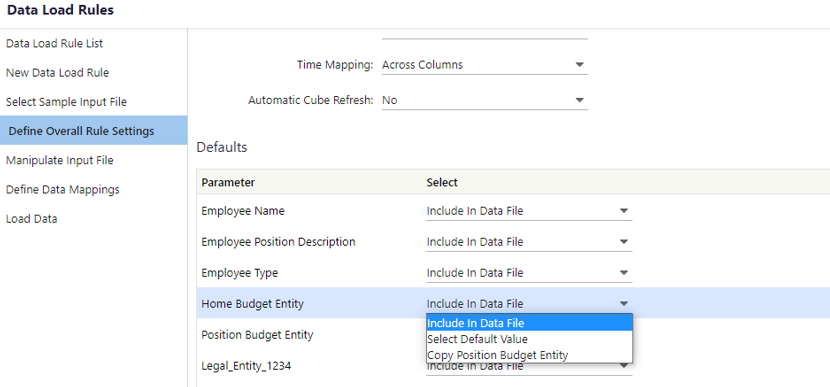- 8 Minutes to read
- Print
- DarkLight
- PDF
Workforce Actuals
- 8 Minutes to read
- Print
- DarkLight
- PDF
Employee Actuals
You can load employee actuals to Workforce Planning at the Employee and Account level for reporting Variance Analysis. This will help to significantly reduce the manual work at the start of every month to update forecasts for Employee Actuals vs. Planned Variance.
This feature will allow you to perform the following:
- Use the Actual Scenario to store Workforce Actuals data by month/period depending on your tenant configuration
- Use Data Load Rule imports to load Actuals into Workforce Planning
- Delete loaded actuals by month to re-import in case of any mistakes
The File load and Copy-Paste options are available for loading.
In Practice:
- Navigate to Maintenance > Data Integration > Data Load Rules.
- Click the New Data Load Rule tab available in the side navigation.
- Enter a Name for the Data Load Rule.
- Select Load Type from the drop-down list. File Load and Copy-Paste are the load types supported by the system.
- Select Workforce Planning as a Load Item from the drop-down list.
- Select Workforce- Employee Actuals as a Load Sub Item from the drop-down list.
.png)
- Now click Next. The Select Sample Input File screen is displayed.
Select Sample Input File Screen: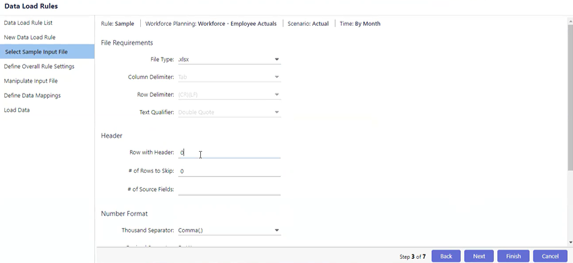
- Fill all the fields with specific data and click Next. The Define Overall Rule Settings screen is displayed.
- Select a Load Currency Type. Local Currency (Allocated Currency) and Common Currency are the two types supported.
- Select an Aggregation at Time Roll up condition from the drop-down list. Default, None, Sum, First, Last, and Avg are the types supported.
- Select a Time Mapping from the list; by default, the value is Across Columns.
- Select Yes as the Automatic Cube Refresh value to avoid manual cube processing.
- Select Include In Data File from the Employee Name drop-down.
- Select Include in Data File Data File from the Employee Position Description drop-down.
- Select Include in Data File or Select from Default Value from Employee Type. When you click Select from Default Value, a drop-down menu is displayed from which you can select the required value. For file load, you should specify the Employee type code and Name.
- Select Include in Data File or Select from Default Value from Home Budget Entity.
- Select Include in Data File or Select from Default Value from Position Budget Entity.
- Select Include in Data File or Select from Default Value from Account dropdown.
- Select Include in Data File or Select from Default Value from Fiscal Year dropdown. When you click Select from Default Value from Fiscal Year, you can select the year from the calendar. Or, you can load from the load file.
- Select Include in Data File or Select from Default Value from Fiscal Month dropdown. When you click Select from Default Value from Fiscal Month, you can select the month from the calendar.
- Click Next. The Manipulate Input File screen is displayed.
Manipulate Input File Screen:
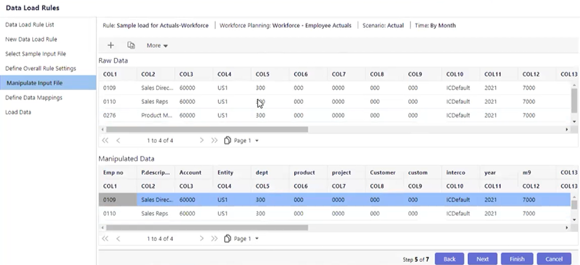
- You need not make any changes to this screen. Click Next to navigate to the Define Data Mappings screen.
Define Data Mappings Screen: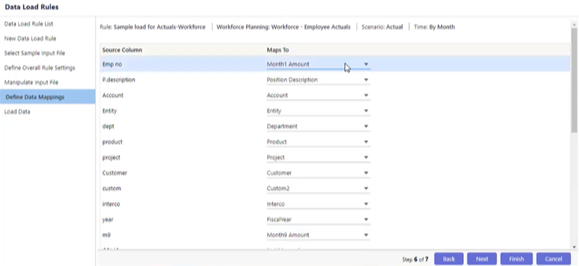
- You need to map fields in the Source Column to values available in the Maps To field drop-down lists.
- Click Next. The Load Data screen is displayed.
Load Data Screen
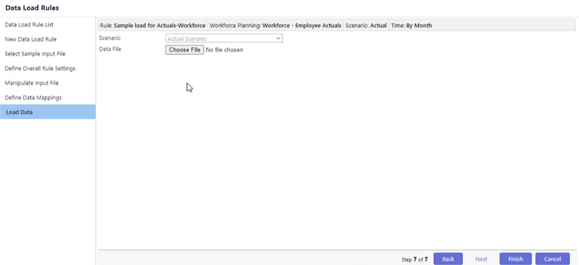
- You can either choose a new Data file or click Finish.
- Once you click Finish, you will either receive a Data Load success message or an exception report.
- You can then navigate to Dynamic Reports and build your custom Variance Report.
Load Successful:
To update the existing data for the specified Actual Scenario, the Employee Number, Employee Name, and Position Description should always match. If the load file contains a combination of valid and invalid rows, the loading is progressive. In cases where the load is partially successful, invalid rows will be skipped, and valid rows will be loaded. For specific periods, users can load Actual amounts. The Actual DLR load is Synchronous.
Data Load Failure Cases:
While loading, if the segment members or periods information is missing in the load file, then the load will fail and an exception report will be generated. If the load file has a new employee that does not exist in any scenario, still the load will be successful and a new record will be created in the Actuals scenario if ‘Reference scenario’ is not selected. If the reference scenario option is selected and the load file has an employee whose details do not match with the Reference scenario, then a load of that particular employee will fail. If the load file has employees with all zeros provided for the amounts for all the specified months, such employees will be skipped from loading. Once the employee details are loaded to the Actual scenario, for subsequent loads for the same employee, the employee number, Employee Name, and Employee Position description should match respectively when no reference scenario is taken. If a reference scenario is taken, the metadata including emp type will be updated as per the Reference scenario into the actual scenario. If the data that exists in the Actual scenario has a mismatch with subsequent load data for “Home Budget Entity, Position Budget Entity” then the load would fail.
Example- Let's say for Alex,“ product management” is his “Home and Position budget entity” in the Actual scenario but if the next load has different details the load would fail.
Workforce Actuals: Webservices Load Type
You can use Webservices to load Workforce Actuals automatically. Once the Workforce Data load is complete, you will receive an email with the load status. This feature will help reduce the manual work of loading Workforce employee actuals and allow you to automate the loading process for any specified time period.
In Practice: To use Webservices in Data Load Rules:
- Navigate to Maintenance > Data Integration > Data Load Rules.
- Click New Data Load Rule available in the side navigation.
- Enter a Name for the Data Load Rule.
- Select Webservices from the Load Type drop-down list. File Load and Copy-Paste are the other two Load Types supported by the system.
- Select Workforce Planning as a Load Item from the drop-down list.
- Select Workforce- Employee Actuals as a Load Sub Itemfrom the drop-down list.
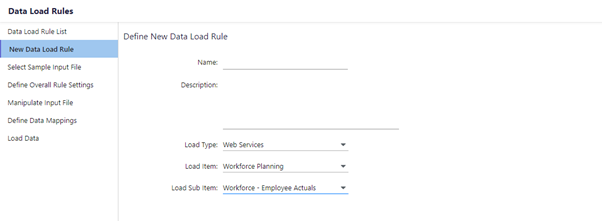
- Now click Next. The Select Sample Input File screen is displayed.
Select Sample Input File Screen:
- Fill all the fields with specific data and click Next. The Define Overall Rule Settings screen is displayed.
Define Overall Rule Settings Screen: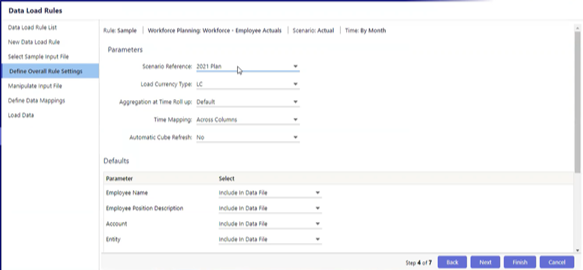
- Fill all the fields with specific data and click Next. The Manipulate Input File screen is displayed.
Manipulate Input File Screen: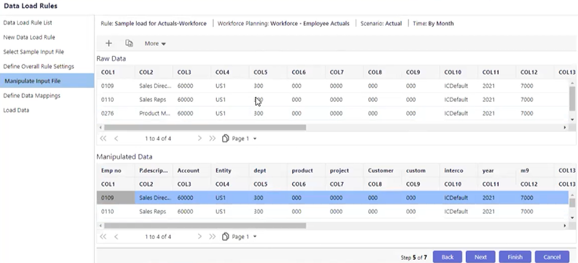
- You need not make any changes to this screen. Click Next to navigate to the Define Data Mappings screen.
Define Data Mappings Screen: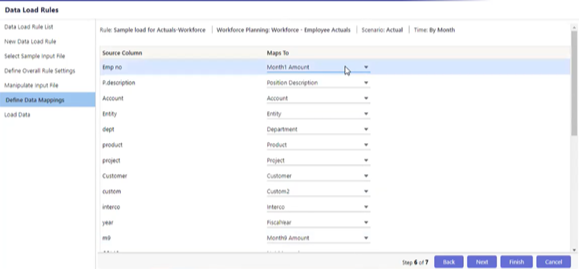
- You need to map fields in the Source Column to the values available in the Maps To field drop-down lists.
- Now, click Next. The Load Data screen is displayed.
Load Data Screen
- Click Finish.
- Once you click Finish, you will receive a Data Load success message.
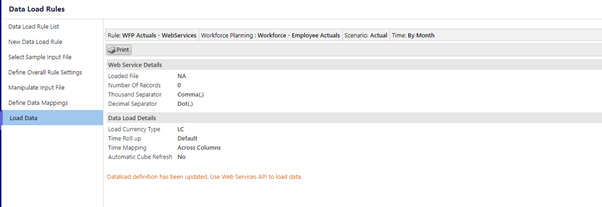
Actuals: File Load
The Workforce Actuals data load rule is now added under the flag Horizon_DataLoad_For_FileUpload. If the flag is enabled, the data is loaded in the Async mode. In the Async mode, you need not wait in the Load Data screen for the data load to complete. Instead, you can navigate to multiple screens and continue work while the data is being loaded.
A new ADC task is added to the Async load. Now, when you click Finish in the Load Data screen, the ADC task is submitted, and a notification confirming the task submission is sent. After the task is completed, you will receive a notification containing details of the load status. You can also see the detailed log of entries in the Job Manager screen. The data is loaded in Sync mode if the flag is not enabled. The Sync and Async functionalities work based on the flag status.

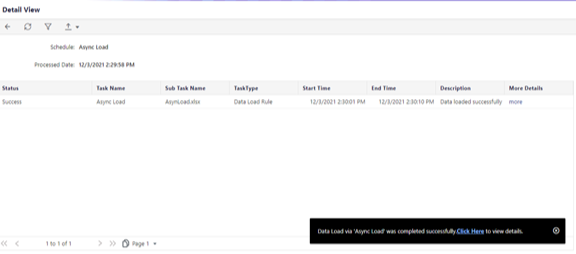
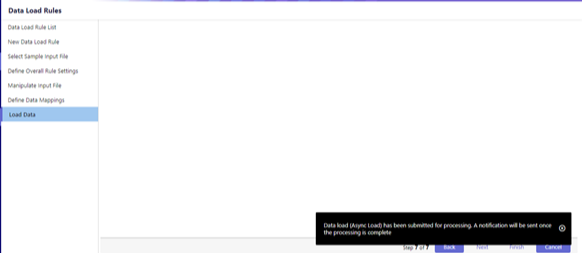
Employee Transfers in Workforce Planning
You can load employee actuals for employees transferred from one budget entity to another. Now, you can load two different budget entities with an employee, provided the entities have the same currency. In this case, the dynamic report will show different entries for the same employee consisting of different entities.
In Practice:
- Navigate to Maintenance > Data Integration > Data Load Rules.
- Click the New Data Load Rule available in the side navigation.
- Enter a Name for the Data Load Rule and fill all the fields with specific data.
- Select Load Type.
- Select Load Item as Workforce Planning.
- Select Load Sub Item as Workforce- Employee Actuals from the drop-down list.
- Fill all the fields with specific data in the following screens and click Next.
- You can choose a new Data file or click Finish in the Load Data Screen.
.png)
Once the data load is successful, you can navigate to Dynamic Reports. In case there are multiple entities mapped to an employee having the same currency, your report will have multiple entries for the same employee.
Copy Over Home or Position Budget Entity Data in Actuals
As a part of Workforce Planning Actuals, you can map Home Budget Entity or Position Budget Entity to the load file and copy over the missing entity while defining the rules to load a DLR. Now, when you choose a Home Budget Entity or Position Budget Entity, you can map the entity from the entity drop-down list instead of revisiting the file to enter the missing value.
The Home Budget Entity and Position Budget Entity contain the following options, and you can use the combination of options in these drop-downs that suit your needs:
- Include in Data File
- Select Default Value
- Copy Home/Position Budget Entity
In Practice: Copy Data from Home or Position Budget Entity
- Navigate to Maintenance > Data Integration > Data Load Rules.
- Click the New Data Load Rule available in the side navigation.
- Enter a Name for the Data Load Rule and fill all the fields with specific data.
- Select Load Item as Workforce Planning and Load Sub Item as Workforce- Employee Actuals from the drop-down list.
- Fill all the fields with required data in the following screens and click Next.
- In the Define Overall Rule Settings screen, fill all the other parameters with data.
- In the Defaults section, select Include In Data File for the required fields
- Select an appropriate option for Home Budget Entity from the drop-down.
- If you have selected Select Default Value, you can select a Home Budget Entity from the pop-up screen.
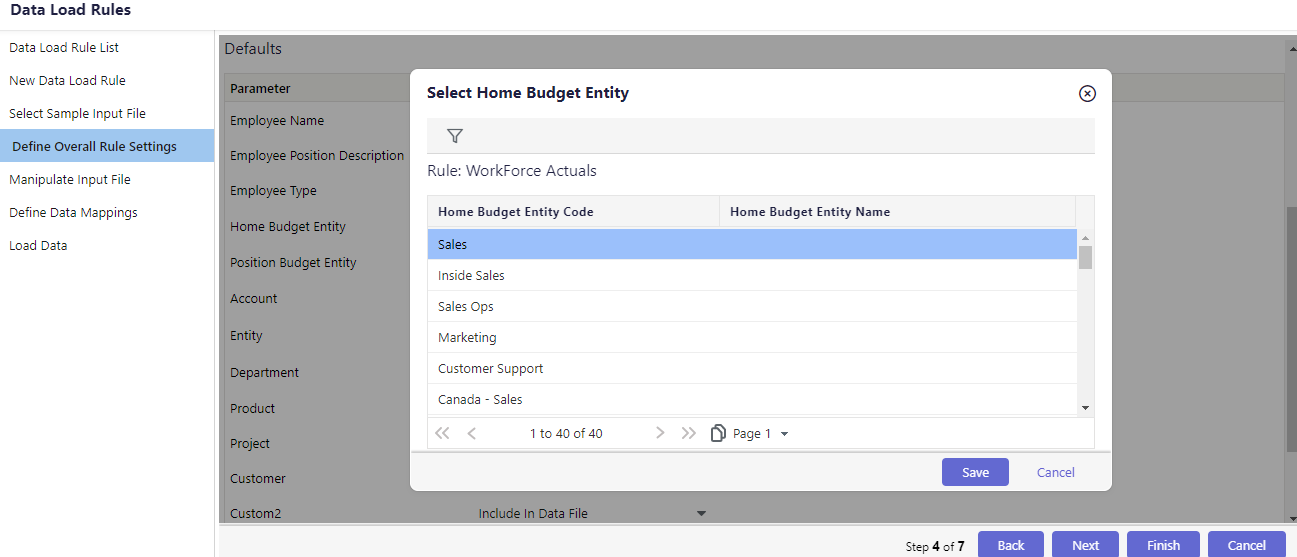
- Based on the option selected for Home Budget Entity, select an appropriate option for Position Budget Entity from the drop-down.
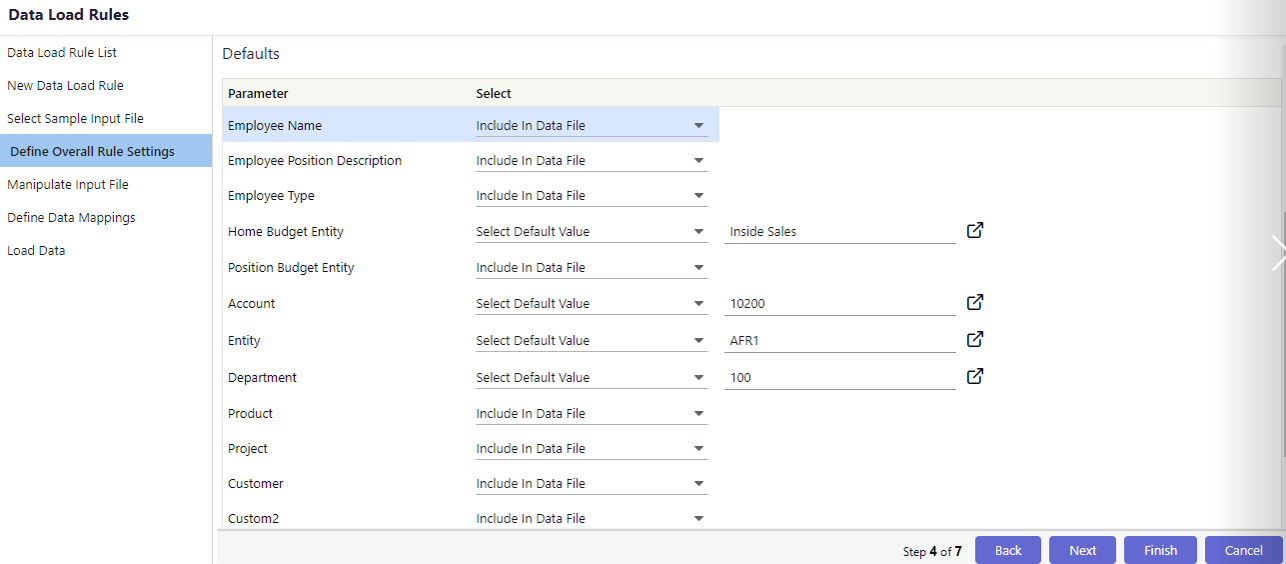
- Fill all the fields with specific data in the following screens and click Next.
- You can choose a new Data file or click Finish in the Load Data Screen.


